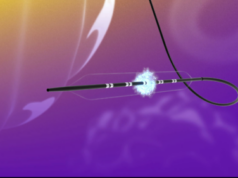A study presented at the Society of Interventional Radiology’s 37th Annual Scientific Meeting in San Francisco, USA, shows that endovascular aneurysm repair (EVAR) is safer than open surgical repair and is associated with lower mortality rates in ruptured abdominal aortic aneurysm.
In the United States, 9% of the population over the age of 65 years has an abdominal aortic aneurysm, and there are 15,000 deaths per year from ruptured abdominal aortic aneurysms. A man is four times more likely to suffer an aneurysm of this kind than a woman, and smokers are also four times as likely to develop the condition.
“Prior to the development of minimally invasive endovascular repair, it was customary for individuals to undergo open surgery, but now the majority of these elective aneurysm repairs are being done by endovascular technique. It is only a question now of getting clinicians and institutions to use the same technique in emergency settings for ruptured aneurysms,” said Prasoon Mohan, co-author of the study from the Department of Diagnostic and Interventional Radiology at Saint Francis Hospital in Evanston, USA.
“We found that endovascular aortic repair resulted in significantly fewer hospital deaths after treatment compared to open surgery, and the hospital stay associated with endovascular repair was less than that of open surgery,” said Mohan.
For this retrospective study, researchers mined the National Inpatient Sample (NIS), the largest national all payer database containing information on around 8 million hospital encounters per year. This database is a part of the larger Healthcare Cost and Utilization Project. The objective was to find all cases of ruptured abdominal aortic aneurysms from 2001 to 2009 that were treated by either endovascular repair or open surgery and to compare their outcomes. They found that 38,858 individuals, with an average age of 74, had ruptured aneurysms and received one of these two treatments. Endovascular repair was used to treat 6,790 patients; 32,069 individuals had open surgery.
The researchers reported that 39.7% of patients who received open surgery died in the hospital, compared to 28.2% of patients who received EVAR. The average length of hospital stay for people who had EVAR was about 11 days, but those who received open surgery stayed almost 14 days. While 35% of patients were able to go home without requiring further in-patient rehabilitation after endovascular repair, only 22% of those who received open surgery were discharged to their homes.
Interestingly, regardless of the type of repair, women had worse outcomes compared to men after the procedure. “Endovascular aortic repair involves less recovery time and fewer discharges to in-patient care facilities, potentially saving insurers, institutions and individuals money,” he added.
“Interventional radiology has made enormous contributions to the progress of modern medicine in the last few decades. No other group of specialists have contributed so many innovations, especially in the field of minimally invasive therapy, for such a broad range of diseases in such a short period of time. Endovascular abdominal aortic aneurysm repair has been one of those great innovations,” said Mohan. “I believe endovascular aortic repair will be the procedure of choice for emergency treatment of ruptured aneurysms in the future. It has proven valuable and it saves lives,” he added.













